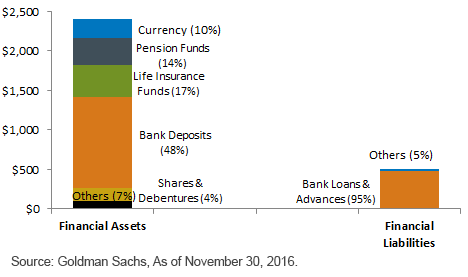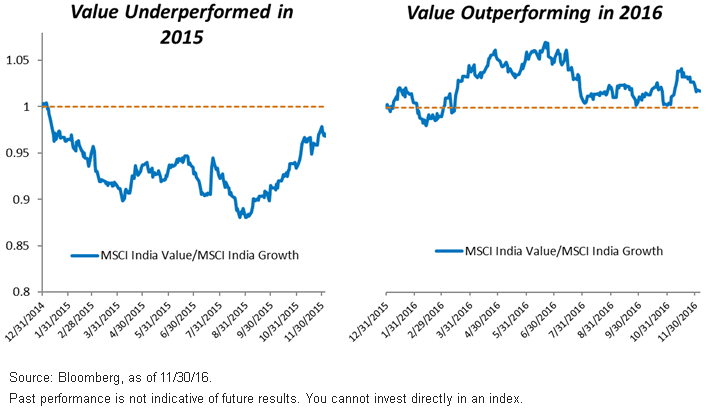Tiger Pounces on Corruption—Implications of India’s Demonetization


Last month, in an unexpected and audacious move, India’s prime minister, Narendra Modi, announced demonetization of 500-and 1,000-rupee notes (~$7.50 and $15, respectively). The process rendered 86% of the circulating currency worthless in a matter of a few hours.1 For context, India has historically been a largely cash economy, and it is a large economy at that—it has the sixth largest gross domestic product (GDP) in the world ($2.3 trillion).2 Below, I will briefly highlight what Modi’s demonetizations could mean to India’s economy from both a strategic and tactical perspective.
What Is Demonetization and Why Was It Done?
Demonetization is the act of stripping a currency unit of its status as legal tender and use. In his announcement, Modi gave the general public 50 days (i.e., until the end of this year) to exchange bills for bank credit as new bills get printed and disbursed through ATMs. A primary reason for this action was to bring all the circulating cash under the legal banking system, thereby curbing unofficial money and the use of cash for illegal or nontaxed activities as well as eliminating counterfeit currency.
Medium-Term Impact of Demonetization—Acceleration Toward Formal Banking!
We believe that, in addition to curbing the parallel unofficial economy, there are long-term benefits to this move. From an economic standpoint, this reform is likely to have a major impact on money supply, consumption spending, inflation and fiscal policy.Looking at the average household balance sheet in India, nearly 10% of financial assets are held in currency (higher than those held in equities and bonds [4%]).3 Over the medium term, as this liquidity rushes to banks, it helps provide a stronger capitalization and funding for the banking system and pushes India toward a cashless society.

More than $80 billion worth of currency notes were exchanged or deposited by the end of November. In the first four days alone, $37 billion was deposited in banks, which is ~2.5% of current system deposits and ~16.5% of demonetized currency in circulation.4
Another near-term repercussion of drying liquidity, weaker near-term demand and prudent spending could be a further reduction in inflation. This should give the Reserve Bank of India (RBI) more room to engage in additional rate cuts. So far, RBI has consecutively cut 175 basis points (bps) starting in January 2015, as we discussed in a previous article, India’s Central Bank: More Rate Cuts under New Leadership.
Sectors Benefitting vs. Sectors Hurt
A reduction in circulating cash is likely to be moderately negative in the short term for spending and for the economy given that consumption accounts for 55% of headline GDP in India.5 In the short to medium term, these actions are likely to hurt sectors such as consumer discretionary, real estate, retail and even consumer staples.
On the brighter side, the influx of capital in banks is not only conducive to long-term growth, but well-capitalized banks imply the ability to pass on lower lending rates to consumers in the medium term. Awhile ago, I emphasized the private banks in India and how they have been adopting technology and mobile banking. I believe as the economy gets less cash dependent and shifts to electronic payments, private banks, which are more tech-friendly, will be the biggest beneficiaries. Paytm, India’s largest mobile wallet company, has already registered a 700% increase in overall traffic and 1,000% growth in the value of money added to its accounts.6
Is Value Making a Comeback?
Though over a long period, value companies in India have historically outperformed, that trend was reversed in 2015 when value stocks lagged growth stocks. However, as shown below, this year value has made a comeback.

For definitions of indexes in the chart, visit our glossary.
I expect in the short term that demonetization will create a growth scare, which would impact growth stocks, while value would be less impacted. Thus, traditional value stocks from sectors such as financials, energy and utilities would be additional side beneficiaries in the current backdrop.
Conclusion
India is at an interesting crossroads where leadership is proactively taking tough reforms for long-term growth. Two pillars of the Indian economy (i.e., banks and consumers) have staggering projected growth numbers. We believe the demonetization move is a much-needed shock to the system that will accelerate the economic migration of consumers to a formal banking system. That makes a compelling strategic case for the economy at large and a specific tactical case for financials and other value-leaning sectors.
WisdomTree’s India Earnings Index (WTIND) is a fundamentally weighted index that gives a unique exposure to profitable companies weighted by their trailing earnings. We believe that due to its methodology, WTIND could be a smart way to access sectors and companies that have been able to grow their earnings along with their price multipliers and therefore are less expensive on a relative basis to the market.
2Source: World Bank, as of 12/15.
3Source: Goldman Sachs, as of 11/16.
4Sources: Morgan Stanley, Economic Times, as of 11/16.
5Source: World Bank, as of 12/15.
6Source: Paytm, as of 11/16.
Important Risks Related to this Article
Investments focused in India increase the impact of events and developments associated with the region, which can adversely affect performance.

